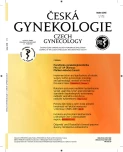Objective assessment of the tissue trauma in surgery of endometrial cancer
Authors:
Milan Kudela; R. Pilka; R. Marek
Authors‘ workplace:
Porodnicko-gynekologická klinika LF UP a FN, Olomouc, přednosta prof. MUDr. R. Pilka, Ph. D.
Published in:
Ceska Gynekol 2013; 78(1): 78-83
Overview
Objective:
To review the current possibilities of objective assessment of tissue trauma in surgical treatment of endometrial cancer.
Type of study:
Review article.
Setting:
Department of Obstetrics and Gynaecology, Faculty of Medicine and Dentistry, Palacky University in Olomouc.
Material and methods:
After critical evaluation of relevant contemporary literature, selected methods of the objective estimation of the extent of tissue trauma are presented. The aim of their choice was to find methods objectivly assessing the extent of tissue trauma in connection with using different types of surgical procedures in endometrial cancer treatment.
Conclusion:
The following clinical and biochemical markers – VAS, KO, CRP, IL-6, neopterin, kynurenin, retinol, α-tocoferol and citrulin seem to be best suitable for the assessment of surgical trauma. These markers should objectivly evaluate the peroperative burden in different types of surgical procedures used for treatment of endometrial cancer. This research is supported by the Czech Grant Agency IGA MZ CR project No. NT 13 566.
Keywords:
tissue trauma – markers of surgical trauma – endometrial cancer
Sources
1. Albina, JE., Mills, CD., Barbul, A., et al. Arginine metabolism in wounds. Am J Physiol, 1988, 254, 4, p. 459–467.
2. Holub, Z., Jabor, A., Sprongl, L., et al. Clinical outcome, inflammatory response and tissue trauma in total laparoscopic hysterectomy: comparison to laparoscopically-assisted vaginal hysterectomy. Čes Gynek, 2002, 67, 6, p. 315–320.
3. Holub, Z., Jabor, A., Sprongl, L., et al. Inflammatory response and tissue trauma in laparoscopic hysterectomy: comparison of electrosurgery and harmonic skalpel. Clin Exp Obstet Gynecol, 2002, 29, 2, p. 105–109.
4. Holub, Z., Jabor, A., Fischlová, D., Palásek, V. Tissue damane in alternative types of hysterectomy: prospective study. Čes Gynek, 1999, 64, 4, p. 227–230.
5. Holub, Z., Jabor, A., Kliment, L., Sprongl, L. Inflammatory response after laparoscopic uterine myomectomy compared to open surgery in current clinical practice. Saudi Med J, 2006, 27, 11, p. 1693–1697.
6. Debats, IB.,Wolfs, TG., Gotoh, T., et al. Role of arginine in superficial wounds healing in men. Nitric Oxide, 2009, 21, 3–4, p. 175–183.
7. Gibson, RJ., Bowen, JM. Biomarkers of regimen-related mucosal injury. Cancer Treat Rev, 2011, 37, 6, p. 487–493.
8. Chen, Y., Guillemin, GJ. Kynurenine pathway metabolites in humans: disease and healthy status. IJTR J, 2009, 2, p. 1–19.
9. Jabor, A., Holub, Z., Franková, J., et al. Serum amyloid A as an effective marker for the essessment of surgical trauma and risk of postoperative complications. Čes Gynek, 2006, 71, 2, p. 131–136.
10. Krč, I. Hematologie – hodnocení krevního obrazu. Urologie pre prax, 2007, 5–6, s. 231–232.
11. Lögters, TT., Laryea, MD., Altrichter, J., et al. Increased plasma kynurenine values and kynurenine-tryptophan ratios after major trauma are early indicators for the development of sepsis. Shock, 2009, 32, 1, p. 29–374.
12. Lutgens, L., Lambin, P. Biomarkers for radiation-induced small bowel epithelial damage: an emerging role for plasma Citrulline. World J Gastroenterol, 2007, 13, 22, p. 3033–3042.
13. Melichar, B., Solichová, D., Freedmans, RS. Neopterin as an indicator of immune activation and prognosis in patients with gynecological malignancies. Int J Gynecol Cancer, 2006, 16, p. 240–252.
14. Muehlberger, T., Moresi, JM., Schwarze, H., et al. The effect of topical tretinoin on tissue strength and skin components in a murine incisional wound model. J Am Acad Dermatol, 2005, 52, 4, p. 582–588.
15. Pintaudi, AM., Tesoriere, l., D´Arpa, N., et al. Oxidative stress after moderate to extensive burning in humans. Free Radic Res, 2000, 33, 2, p. 139–146.
16. Ploder, M., Neurauter, G., Spittler, K., et al. Serum phenylalanine in patients post trauma and with sepsis correlate to nepterin concentrations. Amino Acids, 2008, 35, p. 303–307.
17. Rickards, H., Dursun, SM., Tartar, G., et al. Increased plasma kynurenin and its relationship to neopterin and tryptophan in Tourette´s syndrome. Psychological Med, 1996, 26, p. 857–862.
18. Schmidt, A., Bengtsson, A., Tylman, M., Blonqvist, L. Pro-inflammatory cytokines in elective flap surgery. J Surg Res, 2007, 137, p. 117–121.
19. Sucher, R., Schroecksnadl, K., Weiss, G., et al. Neopterin, a prognostic marker in human malignancies. Cancer Letters, 2010, 287, p. 13–22.
20. Vinha, PP., Jordao, AA., Farina, JA., et al. Inflammatory and oxidative stress after surgery for the small area corrections of burn sequelae. Acta Cir Bras, 2011, 26, 4, p. 320–324.
21. Vissers, YL., von Meyenfeldt, MF., Luisin, YC. et al. Interorgan synthesis of arginine is down-regulated in tumor-bearing mice undergoing surgical trauma. Metabolism, 2008, 57, 7, p. 896–902.
22. Wang, Y., Liu, H., McKenzie, G., et al. Kynurenine is an endothelium-derived relaxing factor produced during inflammation. Nature Med, 2010, 16, p. 279–285.
23. Yan, M., Chen, G., Fang, l., et al. Immunologic changes to autologous transfusion after operational trauma in malignant tumor patients: Neopterin and interleukin-2. J Zhejiang Univ SCI, 2005, 6B, 1, p. 49–52.
24. Zunic, G., Savic, J., Ignjatovic, D., Taseski, J. Early plasma amino acid pool alterations in patients with military gunshot/missile wounds. J Trauma, 1996, 40, 3, p. 152–156.
Labels
Paediatric gynaecology Gynaecology and obstetrics Reproduction medicineArticle was published in
Czech Gynaecology

2013 Issue 1
Most read in this issue
- Influence of the length of cultivation of no early cleavage embryos on the IVF success rate
- Sacrospinous fixation for vaginal vault prolapse after hysterectomy sec. Miyazaki – longterm results
- Erythrocyte alloimmunization in pregnant women, clinical importance and laboratory diagnostics
- Bleeding disorders in pregnancy
